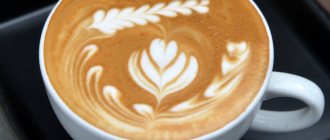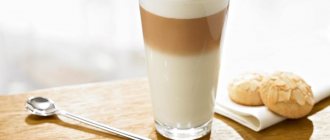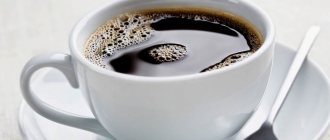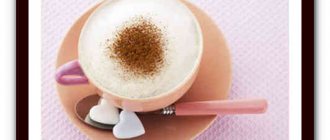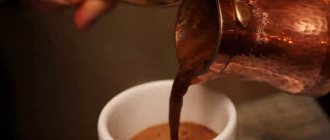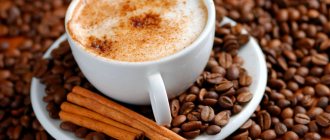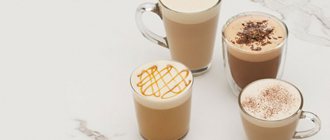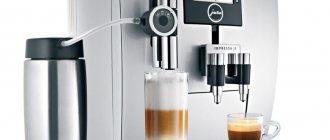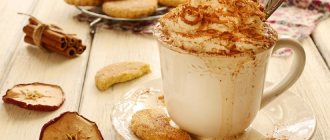Cappuccino is an Italian espresso-based coffee drink. The classic version includes a double portion of black coffee, hot milk and thick milk foam, but some baristas use cream instead of the last two ingredients, and also add cinnamon, chocolate chips, and orange zest to the drink.
Cappuccino has a mild taste with a slight coffee bitterness. If everything is done correctly, the drink should turn out sweet even without adding sugar (due to the fatty milk foamed by the cappuccino maker).
Interesting fact: despite the apparent simplicity of the recipe, making cappuccino is quite difficult. At international barista and coffee competitions, masters often compete in preparing this particular drink.
Story
The name “cappuccino” comes from the Capuchin Order, as the color of the drink resembles the beige-brown robes of the holy brothers. The very word cappucio (Latin: Caputium) is translated from Italian as “hood” - an indispensable attribute of the daily attire of the servants of the order.
Capuchin in a hood drinks cappuccino
The term “cappuccino” first appeared in Italian in 1930, but a similar drink, Kapuziner, existed in Austria back in the 18th century. Then it consisted of coffee, sugar, cream and egg yolks (although it is not known in what proportions). At that time, Italy was under Austrian rule; during the division of countries, cappuccino “changed his citizenship” to Italian.
Fresh milk began to be used instead of cream in the 20th century, when refrigerators appeared. Until the 1950s, the term “cappuccino” meant quite a variety of drinks (with milk or cream, with or without spices), but with the spread of coffee machines, the term was consolidated in its modern meaning.
Manufacturing conditions
In order to properly prepare cappuccino in a coffee machine, you should pay attention to some subtleties. The most important thing is: the choice of a dairy product and the correct selection of dishes in which coffee will be served. The easiest way to make the drink is in a coffee machine with an automatic cappuccino maker.
Characteristics of milk for cappuccino
There are some requirements for this ingredient:
- Fat content. If you use a low-fat product, a milk cap will not form. Fat content must be at least 3.5%.
- The composition of the protein, which determines how dense and soft the foam will be. The required consistency is obtained with a protein content of about 2.8-3.5. Only high-protein milk will create a cap of large, dry bubbles that create visible airiness.
- Initial temperature. The milk must be cold (3-5° C). The temperature of the whipped product should not exceed 75°, otherwise the taste of boiled milk will appear.
You cannot use low-protein, expired milk or dry powdered product to make a coffee drink.
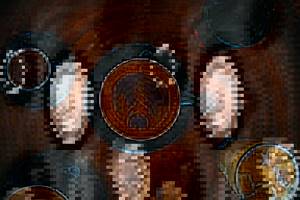
Dishes
To make a real cappuccino, you need to choose the right glassware. Before cooking you need to pay attention to the following points:
- The dishes should be heated to approximately 40°C;
- The appearance of moisture on the container and in the pitcher is unacceptable;
- To serve, use transparent glass or ceramic cups and glasses.
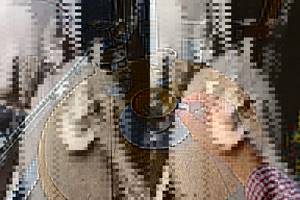
Correct use of the cappuccino maker
The procedure for preparing a coffee drink in a coffee machine depends on the model of the cappuccino maker. With automatic mode, just place the container with milk in the unit and select the correct mode. The foam will flow into the espresso container on its own.
Be sure to read: How to make lungo coffee in a coffee machine
Making cappuccino in a simple coffee machine is a little more complicated, since it uses a manual cappuccino maker.
- The unit should be preheated for 30 minutes, releasing steam from the steam wand in advance.
- Pour milk into the bowl, the volume of which should reach below the spout, as it will increase when whipped.
- The tip of the cappuccino maker must be lowered to the bottom of the container.
- Turn on the steam and very slowly lift the tip up.
- The process is continued until milk foam appears.
Characteristics of cappuccino
| Suitable coffee | A blend of Arabica and Robusta medium roast (proportions may vary). 100% Arabica possible. |
| Composition and proportions | ~15 g of freshly ground coffee beans, 60-90 ml of milk (sometimes more, depending on the recipe, fat content from 3% or higher), 50-100 ml of water. |
| Coffee machine pressure | 8-10 bar. |
| Temperature of ingredients during cooking | Water temperature for espresso is 84-90 degrees, milk temperature is 60-70 degrees. |
| Cooking time | 1 – 2 minutes. |
| Volume of one serving | 150-180 ml, sometimes 360 ml (double cappuccino). |
| Strength (caffeine content) | 50-75 mg per standard serving. |
| Serving temperature | 60-63 °C. |
| Recommended Daily Value | 3-4 servings (180 ml). |
| Calorie content | 36-56 calories (depending on the fat content of the milk). Each level teaspoon of sugar adds another 16 calories to the drink. |
Attention! The figures and proportions given are arbitrary: every good barista has his own recipe, which may differ significantly from the classic one. In the USA, skim milk is often used; other baristas, on the contrary, prefer 11% cream; there is also the half'n'half option - a mixture of cream and milk.
Cappuccino
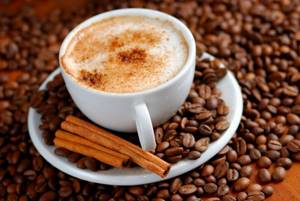
Cappuccino (from Italian cappuccino - capuchin) is a coffee drink of Italian cuisine based on espresso with the addition of milk and milk foam.
An important component of a cappuccino is the properly frothed milk that is poured into the espresso. To make the foam ideal, the temperature of the milk we take for whipping should be +4°C. It is better to take pasteurized rather than homemade milk, 2.5-3.5% fat. Cappuccino coffee consists of 1/3 espresso, 1/3 hot milk and 1/3 milk foam. A standard serving of cappuccino is five to seven ounces, or 150-180 milliliters. To prepare cappuccino, frothed milk is poured into espresso. The milk foam on top of the drink acts as an insulator and helps keep the temperature high longer. In order for the foam to be correct, the temperature of the milk used for whipping must be +4°C.
Serving Served in demitasse with a volume of 150-180 ml. Cappuccino should be served in preheated cups with thick walls and rounded edges that retain heat well. Drink temperature The drink should be 65-70°C. At this temperature, the cappuccino is not very hot, it is comfortable to drink.
History and origin of the name
Cappuccino coffee was born in sunny Italy. Nobody (almost) disputes the fact that it was invented by the Capuchin monks (Monk-Capuchins) of one of the monasteries north of Rome. Unlike “good old England,” the monks drank coffee only with milk. Monks often noticed (although they were not the only ones who noticed this) that when pouring milk, a rather persistent foam was obtained, which was very pleasant to absorb. Capuchin monks, like all ascetics, were deprived of many earthly joys... Therefore, to enjoy coffee is, first of all, to enjoy it.
To make foam, coffee and milk began to be whipped. It turned out quite well, but the foam was unstable, and I wanted something unusual - alpine snow over the sinful earth. It was then that we remembered drinking coffee with whipped cream. But the coffee was hot and the cream was cold. And as everyone knows, cold cream and milk whip more easily. Capuchin monks, like Jonson & Jonson + Dirol & xylitol_and_carbamide, took care of their teeth and did not look for easy ways. They began heating whipped cream by steaming (steam, Italian - the state of water at a temperature of about 100 degrees Celsius at normal atmospheric pressure), and then learned how to whip hot milk and cream with mechanical beaters. There is so much you can learn on the road to God. This went on for quite a long time; legends about the most beautiful drink spread throughout Italy.
The cooking technology was changed by a self-taught mechanic, Giuseppe, who lived near the monastery. He made the first cappuccino machine. The whipping machine consisted of two compartments: in the first, water was heated, which, having turned into steam, fell through a tube into the second compartment. In the second compartment, the milk frothing process took place. This method of frothing milk with hot steam was invented at the end of the 19th century by Padre Carlo (Padre Carlo, a famous monk-inventor, became famous for the invention of one of the methods of processing timber, later called pino-cio, after the place where the inventor was born).
Currently, all coffee makers with a cappuccino maker operate on this principle. The 20th century changed everything, “the century of change.” Cappuccino began to mean anything that contains coffee, on the surface of which milk foam floats. The Nestlé Corporation has released instant cappuccino coffee... The Age of Speed. Added boiling water - cappuccino. Something is leaving. Something that sometimes makes your heart ache.
Differences between cappuccino and other types of coffee
Cappuccino coffee is very similar to a latte, but is served in smaller cups (180 ml versus 300 ml), contains less milk and more milk foam.
Macchiato (Caffe macchiato) consists only of espresso and milk without foam.
Cortado is a Spanish coffee cocktail that contains espresso and milk in proportions of 1:1 or 1:2; condensed milk is often used instead of fresh milk.
“Flat White” is a cross between a cappuccino and a latte; its characteristic feature is a very thin layer of foam, most often with a pattern.
Composition of cappuccino coffee
The list of main ingredients for cappuccino consists of only two items:
Freshly brewed coffee
You can take a shot of espresso, brew coffee in a cezve, geyser coffee maker, or simply brew it in a French press. A prerequisite: hand-brewed coffee must be strained so that particles of grounds do not interfere with the enjoyment of your cappuccino.
Milk
The milk should be frothed or frothed until half of its volume is reduced to a smooth, stable foam. You can take milk of any fat content. If you are making cappuccino at home and want to achieve a good, stable and smooth foam without using a cappuccino machine, then choose a mixture of cream and milk in a 1:1 ratio.
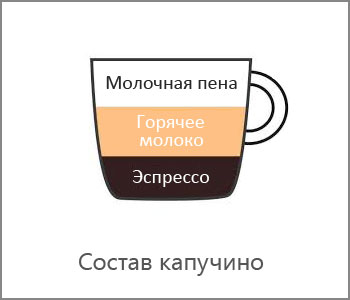
Additional cappuccino ingredients:
- Sugar - cane or caramelized sugar complements the taste of the drink well.
- Decorative topping - the most popular topping for cappuccino is cocoa or cinnamon. Both ingredients can be mixed with powdered sugar.
Classic cappuccino recipe
Traditional proportions of coffee, milk and foam are 1:1:1.
Modern cappuccino is prepared in a coffee machine. First, a double portion of espresso is poured into a coffee glass, then the same amount of hot milk is added, and the composition is crowned with a lush head of milk foam. Another option is also common: the milk is not poured separately, but simply whipped up more foam, so that it not only settles on the drink in a voluminous cap, but also partially dissolves in it.
Ingredients:
- coffee (espresso) – 60 ml;
- milk – 60 ml;
- sugar - to taste.
Cooking technology
1. Pour a double shot of espresso (60 ml) into a tall coffee glass or cup with a minimum volume of 180 ml that has been preheated with steam.
2. Heat the milk to 60-70 °C, then beat it with a cappuccino maker, whisk or mixer into a fine foam until the volume doubles.
3. Holding the foam with a spoon, add milk to the espresso, sweeten with sugar if desired and stir. Place foam on top.
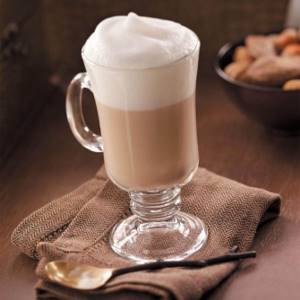
A cappuccino maker is a thin metal tube through which steam is supplied under high pressure. Milk frothed in this way acquires a sweetish taste and a particularly delicate structure due to microscopic bubbles.
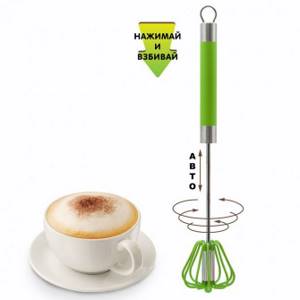
Manual electric cappuccino maker. Many coffee machines have a separate unit for frothing milk.
Alternative recipe. Kapuziner – served in old Viennese cafes, black coffee with a few drops of heavy cream, just to get the right color.
Cappuccino coffee recipe
A classic cappuccino is made with espresso.
Cappuccino proportions:
- 1/3 coffee.
- 1/3 milk.
- 1/3 milk foam.
What is needed to prepare the drink?
- Espresso - 40-50 ml.
- Milk – 80-100 ml.
- Sugar - to taste.
- Flavorings and toppings are optional.
How to make cappuccino?
- Brew a 40-50 ml portion of espresso.
- Pour cooled milk at a temperature of 4-5 degrees into the cappuccino maker and beat until it forms a dense and smooth foam with a finely porous structure. This increases the temperature of the milk, so it is important not to overheat the milk when frothing. It should have a final temperature of 65-75 degrees.
- Pour the prepared coffee into a heated cup, then the milk, and place the remaining foam on the surface of the drink.
- Decorate with sprinkles.
Flavored cappuccino is prepared using the same technology, but topping is added - caramel, chocolate, vanilla or cream. The topping is poured into the coffee before adding the milk.
Cappuccino can be decorated with latte art designs.
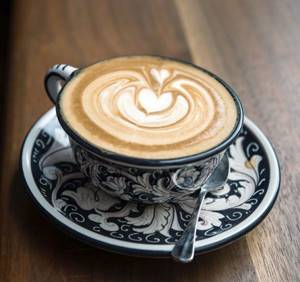
Making cappuccino without a coffee machine at home
There are two methods:
- In the microwave. First, a glass of milk is heated in the microwave at maximum power until small bubbles appear on it (on average this takes less than a minute). It is important to ensure that the liquid does not “run away”. Then beat the hot milk with a whisk or mixer, successively transferring the foam to another cup. When about half of the milk turns into foam, brew a double portion of espresso, pour the remaining milk into it, and spread the foam on top.
- Manually. Coffee is brewed in a Turkish coffee pot or brewed in a French press, and hot milk is whisked. Then all the ingredients are added to the cup.
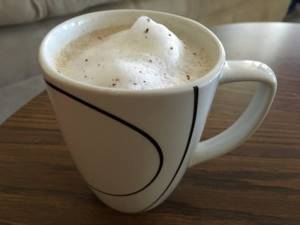
Cappuccino made in the microwave
Types of cappuccino
In addition to the traditional recipe, there are some other variations:
- Latte Art is a regular cappuccino drink, but with a pattern on the milk foam. Some baristas achieve such perfection in this art that they can even paint a portrait of a guest.
- Wet cappuccino (“wet” cappuccino) is a cocktail in which the ratio of coffee, milk and foam is shifted in favor of milk.
- Dry cappuccino (“dry” cappuccino) is the opposite of the previous option; this recipe contains less milk than other ingredients (there may be more or the same amount of foam).
- Iced cappuccino (cappuccino with ice) – in a blender, beat chilled black coffee and milk (1:2 ratio), ice cubes, sugar to taste. You can also add syrup and/or spices, or replace the milk with cream (partially or completely).
- Cappuccino Freddo (cold cappuccino) - prepared like a regular cappuccino, only all ingredients must be cold, including frothed milk.
- Babyccino is frothed milk without coffee (and therefore decaffeinated), often served with syrup.
Calorie content of cappuccino coffee
The calorie content of cappuccino varies depending on the fat content of the milk, the presence or absence of sugar, and topping.
Cappuccino calorie table
| Composition of the drink | Calorie content of 100 ml cappuccino | Calorie content of a serving of cappuccino (150 ml) |
| Cappuccino with milk 2.5% fat | 36 kcal | 54 kcal |
| Cappuccino with milk 3.2% fat | 41 kcal | 61 kcal |
| Cappuccino with a mixture of milk and cream 10% fat | 60 kcal | 90 kcal |
| Cappuccino with 1 tsp. Sahara | 50 kcal | 74 kcal |
| Cappuccino with sugar and cocoa sprinkles | 54 kcal | 80 kcal |
| Cappuccino with flavoring (topping) without sugar | 54 kcal | 80 kcal |
| Cappuccino with flavoring (topping) and sugar | 67 kcal | 100 kcal |
How to serve and drink cappuccino
In continental Europe, cappuccino is traditionally drunk in the morning, mainly at breakfast, with a croissant, white toast or other pastries. In Italy, it is even considered bad manners to drink this coffee cocktail after 11 o’clock in the afternoon and/or have something substantial, like meat or a hot dish - with all the Italians’ love for coffee, they prefer espresso after lunch.
Americans drink cappuccino throughout the day and are not averse to finishing off a hearty meal with it.
As already mentioned, a classic cappuccino is served in a preheated coffee glass or porcelain cup with a volume of 150-180 ml, but in fast foods and coffee shops like Starbucks there are portions up to 600 ml in volume.
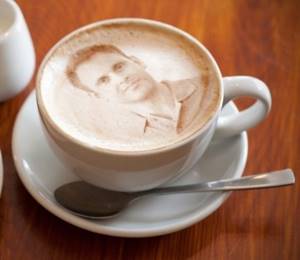
Portrait on a cup of cappuccino, it’s even a pity to drink this
How to drink cappuccino correctly?
The ideal way to drink cappuccino is to drink it without stirring, passing the coffee and milk through a layer of airy foam. In order to avoid mixing, sweet toppings were added to cappuccino for those with a sweet tooth.
Some skim off the foam with a spoon and only then start drinking coffee. This is not entirely correct, since with this use there is no opportunity to enjoy a real bouquet of cappuccino.
According to gourmets, sugar spoils the taste of cappuccino, so coffee lovers do not put any sweeteners in their cappuccino. Silky foam and milk sufficiently soften the coffee bitterness.
Italians believe that cappuccino time is morning until noon, or better yet, before 11 o’clock. They do not advise drinking it after meals, as milk slows down and impairs digestion.
